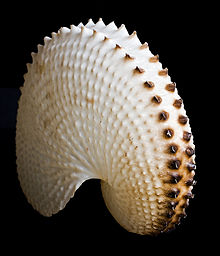
A cephalopod is any member of the molluscan class Cephalopoda such as a squid, octopus, cuttlefish, or nautilus. These exclusively marine animals are characterized by bilateral body symmetry, a prominent head, and a set of arms or tentacles modified from the primitive molluscan foot. Fishers sometimes call cephalopods "inkfish", referring to their common ability to squirt ink. The study of cephalopods is a branch of malacology known as teuthology.

The nautilus is a pelagic marine mollusc of the cephalopod family Nautilidae. The nautilus is the sole extant family of the superfamily Nautilaceae and of its smaller but near equal suborder, Nautilina.

The argonauts are a group of pelagic octopuses. They are also called paper nautili, referring to the paper-thin eggcase that females secrete. This structure lacks the gas-filled chambers present in chambered nautilus shells and is not a true cephalopod shell, but rather an evolutionary innovation unique to the genus. It is used as a brood chamber, and to trap surface air to maintain buoyancy. It was once speculated that argonauts did not manufacture their eggcases but utilized shells abandoned by other organisms, in the manner of hermit crabs. Experiments by pioneering marine biologist Jeanne Villepreux-Power in the early 19th century disproved this hypothesis, as Villepreux-Power successfully reared argonaut young and observed their shells' development.

Argonauta argo, also known as the greater argonaut, is a species of pelagic octopus belonging to the genus Argonauta. The Chinese name for this species translates as "white sea-horse's nest".
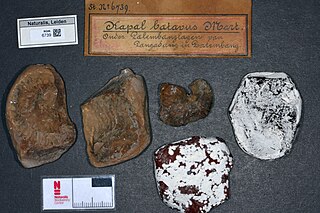
Kapal is a monotypic genus of shelled octopods comprising the species Kapal batavus.

Argonauta nouryi, also known as Noury's argonaut, is a species of pelagic octopus. The female of the species, like all argonauts, creates a paper-thin eggcase that coils around the octopus much like the way a nautilus lives in its shell. The shell is usually approximately 80 mm in length, although it can exceed 90 mm in exceptional specimens; the world record size is 95.5 mm.

Argonauta hians, also known as the winged argonaut, muddy argonaut or brown paper nautilus, is a species of pelagic octopus. The common name comes from the grey to brown coloured shell. The Chinese name for this species translates as "Grey Sea-horse's Nest". The female of the species, like all argonauts, creates a paper-thin eggcase that coils around the octopus much like the way a nautilus lives in its shell. The eggcase is characterised by a wide keel that gives it a square appearance, few rounded tubercles along the keel, and less than 40 smooth ribs across the sides of the shell. The shell is usually approximately 80 mm in length, although it can exceed 120 mm in exceptional specimens; the world record size is 121.5 mm.

Argonauta cornuta is a species of pelagic octopus belonging to the genus Argonauta. The female of the species, like all argonauts, creates a paper-thin eggcase that coils around the octopus reminiscent of the way a nautilus lives in its shell. The shell is usually approximately 80 mm in length, although it can exceed 90 mm in exceptional specimens; the world record size is 98.6 mm.

Argonauta pacifica, also known as the Pacific argonaut, is a species of pelagic octopus. The female of the species, like all argonauts, creates a paper-thin eggcase that coils around the octopus much like the way a nautilus lives in its shell. The shell is usually approximately 150 mm in length, although it can exceed 200 mm in exceptional specimens; the world record size is 220.0 mm.
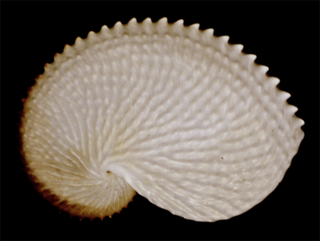
Argonauta nodosus [previously known as Argonauta nodosa], also known as the knobby or knobbed argonaut, is a species of pelagic octopus. The female of the species, like all argonauts, creates a paper-thin eggcase that coils around the octopus much like the way a nautilus lives in its shell. The shell is usually approximately 150 mm in length, although it can exceed 250 mm in exceptional specimens; the world record size is 292.0 mm. A. nodosus produces a very characteristic shell, which is covered in many small nodules on the ridges across the shell, hence the specific epithet nodosus and common name. These nodules are less obvious or even absent in juvenile females, especially those under 5 cm in length. All other argonaut species have smooth ridges across the shell walls.
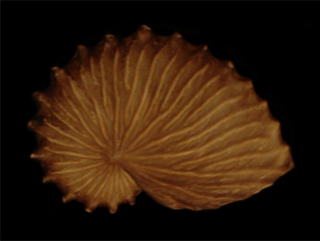
Argonauta bottgeri, also known as Böttger's argonaut, is a species of pelagic octopus belonging to the genus Argonauta. The female of the species, like all argonauts, creates a paper-thin eggcase that coils around the octopus much like the way a nautilus lives in its shell.

Incirrata is a suborder of the order Octopoda. The suborder contains the classic "benthic octopuses," as well as many pelagic octopus families, including the paper nautiluses. The incirrate octopuses are distinguished from the cirrate octopuses by the absence in the former of the "cirri" filaments for which the cirrates are named, as well as by the lack of paired swimming fins on the head, and lack of a small internal shell.

Octopodiformes is a superorder of the subclass Coleoidea, comprising the octopuses and the vampire squid. All living members of Octopodiformes have eight arms, either lacking the two tentacles of squid or modifying the tentacles into thin filaments. Octopodiformes is often considered the crown group of octopuses and vampire squids, including all descendants of their common ancestor. Some authors use the term Vampyropoda for the same general category, though others use "Vampyropoda" to refer to the total group. Another term is Octobranchia, referring to cephalopods without prominent tentacles.
Izumonauta is an extinct genus of shelled octopods from the Mid to Late Miocene of Japan and New Zealand.
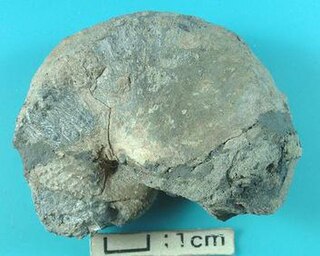
Mizuhobaris is an extinct genus of shelled octopods from the Late Miocene.

Obinautilus is an extinct genus of shelled cephalopod that has been variously identified as an argonautid octopod or a nautilid. It is known from the Late Oligocene to Pliocene of Japan. The shell is discoidal and very involute, with rapidly expanding and compressed whorls, fine radial ribs, a rounded venter with a shallow furrow, and almost closed umbilicus.
Argonauta tokunagai is an extinct species of octopus. It was described in 1913 based on fossil material from the Middle Miocene Huzina Formation of Japan.
The cephalopods have a long geological history, with the first nautiloids found in late Cambrian strata, and purported stem-group representatives present in the earliest Cambrian lagerstätten.
Argonauta oweri is an extinct species of argonautid octopus. It is known from the early Pliocene of New Zealand.

Argonautoidea is a superfamily of the suborder Incirrata containing all known argonautoids.
